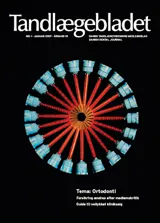Ortodonti i relation til oral funktion
Artikeln tar inledningsvis upp tuggmuskelfunktionens viktiga roll för ansiktsskelettets tillväxt. Författarna redogör sedan för vikten av att utveckla, testa och utvärdera olika behandlingsmetoder för att normalisera käktillväxt, orofacial funktion och bettutveckling hos funktionshindrade. Slutligen tar artikeln upp behandlingseffekter och biverkningar av behandling av sömnapné med så kallad modifierad funktionskäkortopedisk apparatur, MRA (mandibular repositioning appliance).
Orthodontics in relation to oral function: The association between the activity of masticatory muscles and craniofacial development has been studied in man as well as in animals. The common finding of these investigations is that the muscles closing the mandible influence the transversal and the vertical dimensions of the craniofacial skeleton. The loading of the facial bones due to masticatory muscle function may stimulate sutural growth and increase bone apposition, leading in turn to an increase of the transversal growth of the maxilla and broader bone bases for the dental arches. The big functional demands of the masticatory muscles are often associated with anterior growth rotation pattern and well-developed angular, coronoid, and condylar processes in the mandible.Individuals with disabilities have an increased prevalence of malocclusion and poor oral function. Behavioural problems and deviating orofacial growth and function will complicate the orthodontic treatment. But with behavioural and various treatment modifications, we can give those patients a well adopted orthodontic treatment. That may favour the facial appearance, achieving a better mouth closure and improve the possibilities to eat and speak. The development and critical evaluation of treatment methods aiming towards normalizing craniofacial and occlusal development is essential. Modified functional appliances such as the »mandibular repositioning appliance« (MRA) has in placebo controlled studies been shown to reduce periods of respiratory arrest and snoring in patients with mild apnea. This method may also be an alternative in more severe cases where patients do not accept treatment with continuous overpressured air (CPAP). Successful treatment of sleep apnea must be based on a close cooperation of dentists with knowledge in this field and doctors at sleep apnea clinics. Effects and side effects of treatment must be supervised during long periods.


